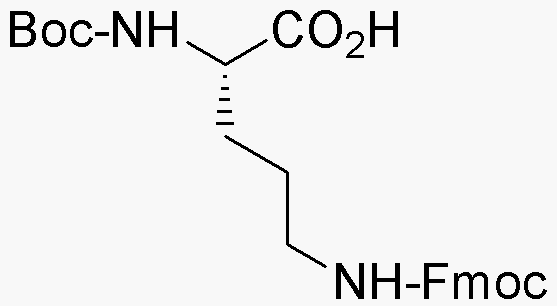Na-Boc-Nd-Fmoc-L-ornithine is widely utilized in research focused on:
- Peptide Synthesis: This compound serves as a key building block in the synthesis of peptides, particularly in the development of therapeutic proteins and vaccines.
- Drug Development: It plays a significant role in the pharmaceutical industry for creating novel drug candidates, especially in targeting specific biological pathways.
- Bioconjugation: The compound is used in bioconjugation processes, allowing researchers to attach drugs or imaging agents to biomolecules, enhancing their efficacy and specificity.
- Research in Cancer Therapy: It is applied in studies aimed at developing targeted cancer therapies, leveraging its ability to modify peptides for improved tumor targeting.
- Protein Engineering: This chemical is instrumental in protein engineering, enabling scientists to design proteins with enhanced stability and functionality for various applications.
General Information
Properties
Safety and Regulations
Applications
Na-Boc-Nd-Fmoc-L-ornithine is widely utilized in research focused on:
- Peptide Synthesis: This compound serves as a key building block in the synthesis of peptides, particularly in the development of therapeutic proteins and vaccines.
- Drug Development: It plays a significant role in the pharmaceutical industry for creating novel drug candidates, especially in targeting specific biological pathways.
- Bioconjugation: The compound is used in bioconjugation processes, allowing researchers to attach drugs or imaging agents to biomolecules, enhancing their efficacy and specificity.
- Research in Cancer Therapy: It is applied in studies aimed at developing targeted cancer therapies, leveraging its ability to modify peptides for improved tumor targeting.
- Protein Engineering: This chemical is instrumental in protein engineering, enabling scientists to design proteins with enhanced stability and functionality for various applications.
Documents
Safety Data Sheets (SDS)
The SDS provides comprehensive safety information on handling, storage, and disposal of the product.
Product Specification (PS)
The PS provides a comprehensive breakdown of the product’s properties, including chemical composition, physical state, purity, and storage requirements. It also details acceptable quality ranges and the product's intended applications.
Certificates of Analysis (COA)
Search for Certificates of Analysis (COA) by entering the products Lot Number. Lot and Batch Numbers can be found on a product’s label following the words ‘Lot’ or ‘Batch’.
*Catalog Number
*Lot Number
Certificates Of Origin (COO)
This COO confirms the country where the product was manufactured, and also details the materials and components used in it and whether it is derived from natural, synthetic, or other specific sources. This certificate may be required for customs, trade, and regulatory compliance.
*Catalog Number
*Lot Number
Safety Data Sheets (SDS)
The SDS provides comprehensive safety information on handling, storage, and disposal of the product.
DownloadProduct Specification (PS)
The PS provides a comprehensive breakdown of the product’s properties, including chemical composition, physical state, purity, and storage requirements. It also details acceptable quality ranges and the product's intended applications.
DownloadCertificates of Analysis (COA)
Search for Certificates of Analysis (COA) by entering the products Lot Number. Lot and Batch Numbers can be found on a product’s label following the words ‘Lot’ or ‘Batch’.
*Catalog Number
*Lot Number
Certificates Of Origin (COO)
This COO confirms the country where the product was manufactured, and also details the materials and components used in it and whether it is derived from natural, synthetic, or other specific sources. This certificate may be required for customs, trade, and regulatory compliance.


